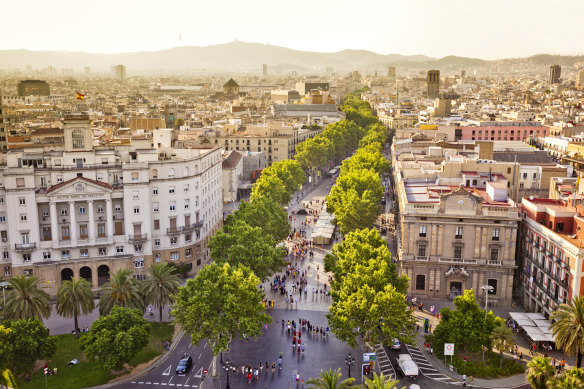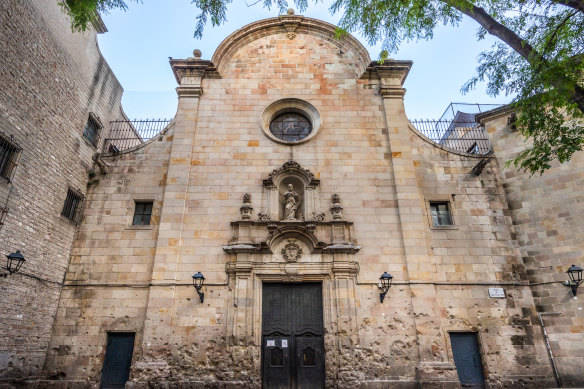The conflict that shook Spain’s most beautiful city
By Tim Richards
The woman is smiling at the camera with a rifle slung over her shoulder and the world is at her feet. But there is so much trouble yet to come.
In Placa de Catalunya, a broad square in central Barcelona, this photo held by tour guide Nick Lloyd is a portal to a different time. It shows the same square back in 1936, and at its centre is Marina Ginesta, a young socialist reporter. A military uprising has just been quashed, but the Spanish Civil War is about to begin.

La Rambla, Barcelona: The city’s famous promenade.Credit: iStock
And that’s the topic of Lloyd’s tour: how the civil war unfolded in Barcelona. Though today this beautiful Spanish city is renowned for its good food and impressive architecture, in the late 1930s it was the focus of political upheaval. Our guide is a Brit who has lived in the city for many years, becoming interested in the conflict when he encountered a photo of a young man who went off to fight.
As his fascination grew he amassed a collection of artefacts which he carries on his tours – referring to them as his “walking museum”. As we stand in the square, hearing Nick explain the origins of the conflict and the different groups involved, we pass around badges from overseas campaigns to aid Spanish democracy, photos of the aftermath of urban battles, and reproductions of magazine covers and illustrations. One item that’s particularly striking is a poster produced by the Barcelona barbers’ collective, with a white-coated barber standing next to his chair while breaking apart a chain.

An 18th century church of the Oratory of Saint Philip Neri with facade bearing holes from the Spanish Civil War.Credit: iStock
Nick points out the former site of the Hotel Colon. Its roof was where Ginesta was standing in the famous photo, and mentions it was decorated by large portraits of Lenin and Stalin when occupied by the communist party. Then we get walking along La Rambla, the city’s famous promenade, before pausing to hear about author George Orwell in front of a hotel he stayed at in late 1936. After getting a lecture from the hotel manager on the evils of tipping, Orwell was impressed by the workers’ control of industries; later getting caught up in the fighting and writing Homage to Catalonia as a result.
A rest stop at a cafe called Menage a Trois is a chance for our guide to expand on the role of international fighters in the civil war and to pass around more relics of the conflict. There’s a bullet casing converted to a pencil holder; a dented shaving stick used by an American volunteer; photos of overseas fighters; a poster from a “popular Olympics” held as an alternative to the Berlin Olympics; and, remarkably, a cigarette lighter with an embedded bullet.
Seated around a long table, we’re asked to each nominate the object or photo that’s moved us the most. For me it’s the bullet pencil holder: at the same time a symbol of education and a symbol of destruction.
On the move again, we end the tour in a pretty square with a cafe in the city’s atmospheric Gothic Quarter. A bomb was once dropped here by the forces of General Franco, whose right-wing Nationalists finally conquered the city in 1939. It’s a dark story, but for some there’s a happy ending. Marina Ginesta, we learn, escaped to France then Venezuela, and ended up settling in Paris and living until 2014. Nick shows us a photo of her in her later years, in which she’s holding a copy of the iconic photograph from 1936.
It’s been an impressive tour, both informative and moving. History may or may not repeat, I reflect, but today it’s added depth to my experience of Barcelona.
THE DETAILS
FLY & RIDE
Emirates flies to Barcelona via Dubai, see emirates.com
Barcelona can also be reached by train from other European cities; for itinerary planning and passes see eurail.com
STAY
Claris Hotel & Spa is a classy place to stay within a heritage building in the Eixample neighbourhood. Rooms from €260 ($426) a night. See hotelclaris.com
TOUR
The Spanish Civil War Tour costs €30 ($50), see thespanishcivilwar.com
The writer paid for this tour, and travelled to Spain courtesy of Eurail and Small Luxury Hotels of the World.
Sign up for the Traveller Deals newsletter
Get exclusive travel deals delivered straight to your inbox. Sign up now.